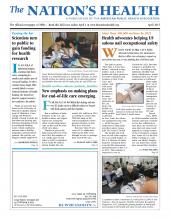In an era of tightening budgets, scientists find themselves competing for smaller and smaller pots of research funding. So when scientist Susan Nagel, PhD, recently failed to secure National Institutes of Health funding, she turned her plea for support toward a new audience: the public.
Nagel, an associate professor in the University of Missouri-Columbia Department of Obstetrics, Gynecology and Women’s Health, wanted to study the link between fracking and hormone-disrupting activity in residential drinking water, which could pose adverse risks to fertility, pregnancy and fetal development. She and her colleagues initially applied for NIH funding, but while the agency’s proposal reviews were positive, the fracking study was not funded. Nagel wanted to keep her fracking research moving forward between grant cycles, so on a tip from a graduate student, she turned to crowdfunding.

Photo by Kara Grubis, courtesy iStockphoto
Generally defined as raising small amounts of money from large groups of people via the Internet, crowdfunding is often associated with more artistic projects, such as filmmaking, fashion or music. But recently, crowdfunding has emerged as a viable way to fund or supplement scientific research as well, with crowdfunding sites such as Experiment.com and Petridish.org devoted to helping scientists develop dynamic campaigns in support of their research and ultimately attract donations and followers. Nagel used Experiment.com for her crowdfunding project — she needed to raise $25,000, which would cover field work, travel expenses, supplies and lab testing. And it was an all-or-nothing scenario. In other words, she had to reach her funding goal to get any money at all.
Fortunately, in June 2014, Nagel accomplished her goal. With about 150 donors giving sums ranging from $25 to $5,000, Nagel hit her crowdfunding target in about 100 days. With the funds, Nagel and her colleagues were able to collect samples from 48 sites in Garfield County, Colorado, an area of intense drilling and where Nagel had conducted previous fracking research. However, Nagel’s crowdfunding success entailed much more than simply posting a plea for donations. It required a significant commitment of time and energy to drum up publicity and interest. Nagel’s site received about 40 page views for every one donation — “that’s a lot of traffic that has to be driven to the site consistently,” she said.
“It’s a steep learning curve,” Nagel told The Nation’s Health. “But now that I’ve done it once, I think I’m much more likely to do it again in the future. We built up a good support base and hopefully we can call on them again.”
From Ebola research to sexual health education, scientists are increasingly interested in crowdfunding as an alternative to more traditional sources of funding, such as NIH or the National Science Foundation. Jai Ranganathan, PhD, co-founder and director of the SciFund Challenge, a nonprofit organization dedicated to empowering scientists with the tools and knowledge to engage the public, said a real advantage to crowdfunding is that it diversifies a researcher’s funding, which offers real benefits in a time when funding is not only harder to get, but more unpredictable — “it’s often feast or famine,” he said of the current funding environment. As an example of crowdfunding’s potential, Ranganathan noted that the crowdfunding site Kickstarter.com now distributes more funds than the National Endowment for the Arts.
“But the key point is this: If you don’t do the outreach, you don’t get the cash,” Ranganathan told The Nation’s Health. “People don’t just randomly show up on your page; they show up because you’re mercilessly beating the gong. Whether it’s social media, public talks, writing blog posts, making videos — it really doesn’t matter. The most important thing above all else is consistent engagement.”
Crowdfunding is not just being used to fund public health research, however. The University of California-Los Angeles has its own crowdfunding platform, Spark, to support student and staff projects, some of which are health-related. Among those that have recently been funded include a campaign that will teach parents about food choking hazards, an art project for heart failure patients and outreach on concussion prevention for underserved athletes.
Ranganathan said the success of crowdfunding is often reported inaccurately in the media, with the standard story involving a project that suddenly goes viral and the money simply starts pouring in. That description makes crowdfunding seem “kooky and mysterious, but it’s neither of those things — it’s actually very predictable,” he said. At the core of crowdfunding success, Ranganathan said, is building an audience. But unlike crowdfunding projects for art or software, in which people fund a particular product, the outcome of funding science is knowledge. And because there is often no tangible product in science, scientists must learn how to sell a new kind of product — themselves.
“The real purpose is to let people in on the scientific journey,” Ranganathan said. “It’s not about one experiment. In the end, what people are paying for is not a result, but a connection to the scientist. In a sense, it’s irrelevant how the science goes.”
When Louisa Edgerly, PhD, graduated with her doctorate degree in communication in the middle of a collapsing economy, she managed to find a job as an adjunct instructor, but what she really wanted to do was research. In particular, Edgerly wanted to travel to the Republic of Congo to learn more about the International Conservation and Education Fund and its success in crafting health messages aimed at hard-to-reach and impoverished communities and to study whether the messaging strategies could be duplicated in other settings to help prevent disease pandemics.
Unfortunately, with no institutional affiliation and little research experience, her chance for federal funding was not promising. So, Edgerly turned to crowdfunding. In 2012, she put up a page on Petridish.org with a goal of raising $7,000 and embarked on an intense outreach campaign.
She began by reaching out to her own network of friends, family and colleagues and asked them to spread the word as well. She also offered different gifts based on the level of donation, such as a printed photo from her travels. In 52 days, Edgerly hit her fundraising goal and was able to spend two months in the Republic of Congo in late 2012. She eventually presented her research findings at a national communications conference. Edgerly said that while it was “amazingly reaffirming to see that people believed in my research,” she would recommend crowdfunding with caution.
“I think people need to undertake it with a realistic understanding of what it can and cannot do,” said Edgerly, an adjunct lecturer at Seattle University’s Department of Communication. “In my experience, it hasn’t turned out to be the answer to the lack of institutional support or the slashing of research funding.”
Hope Leman, MLIS, an Oregon-based grant consultant, said to think of crowdfunding as “microfunding.” In a January 2013 article on a Health Affairs blog, Leman wrote that in addition to raising funds, crowdfunding also gives new scientists a chance to impress traditional health research funders, who now have the chance to follow a researcher’s scientific journey and growth online. Leman, who presented on crowdfunding at the 2013 annual meeting of the Oregon Public Health Association, said crowdfunding may be a particularly helpful resource for young researchers, especially when considering that the average age of a researcher when receiving her or his first NIH grant is 45.
“People should follow (crowdfunding) and be cautious,” she told The Nation’s Health. “But don’t be so cautious that you don’t take advantage of it, because I do think that crowdfunding is here to stay.”
APHA member Yue Liao, MPH, a PhD candidate in health behavior research at the University of Southern California, said her crowdfunding experience helped her hone her public communication skills. As of late February, Liao was in the midst of trying to raise $1,500 on Experiment.com to supplement her research on how a mother’s emotional state might affect her children’s physical activity levels, which could eventually inform interventions to promote exercise among youth. While much of the research is supported through an NIH grant, the crowdfunding money would support new recruitment incentives and promotional items. Liao said that while she and her colleagues began recruitment last summer and hoped to recruit 200 mothers and 200 children to participate in the study, they have enrolled less than half that number.
To support their crowdfunding campaign, Liao and her colleagues held a launch event, contacted local media, reached out to parenting blogs and even held a discussion on the social media site Reddit.
“In the process of preparing this campaign, I needed to think about why people should care about my work,” Liao told The Nation’s Health. “I always thought that what I’m doing is relevant to people’s health, but not until I did (crowdfunding) did I realize that I need to use different language to really connect with people…I’d definitely do crowdfunding again — it’s not only about getting money, but getting exposure for your research.”
To learn more about crowdfunding, visit www.scifundchallenge.org.
- Copyright The Nation’s Health, American Public Health Association









